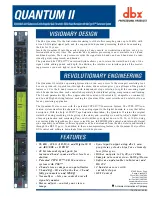
www.ti.com
SM320C6455-EP
FIXED-POINT DIGITAL SIGNAL PROCESSOR
SPRS462B – SEPTEMBER 2007 – REVISED JANUARY 2008
Table 2-3. Terminal Functions (continued)
SIGNAL
TYPE
(1)
IPD/IPU
(2)
DESCRIPTION
NAME
NO.
EMIFA (64 BIT) - ADDRESS
AEA19/BOOTMODE3
N25
EMIFA external address (word address) (
O/Z
)
Controls initialization of the DSP modes at reset (
I
) via pullup/pulldown resistors
AEA18/BOOTMODE2
L26
[For more detailed information, see
Section 3
,
Device Configuration
.]
AEA17/BOOTMODE1
L25
Note:
If a configuration pin must be routed out from the device and 3-stated
O/Z
IPD
(not driven), the internal pullup/pulldown (IPU/IPD) resistor should not be relied
AEA16/BOOTMODE0
P26
upon; TI recommends the use of an external pullup/pulldown resistor. For more
AEA15/AECLKIN_SEL
P27
detailed information on pullup/pulldown resistors and situations where external
pullup/pulldown resistors are required, see
Section 3.7
,
Pullup/Pulldown
AEA14/HPI_WIDTH
R25
Resistors
.
AEA13/LENDIAN
R27
O/Z
IPU
•
Boot mode - device boot mode configurations (BOOTMODE[3:0]) [
Note:
AEA12/UTOPIA_EN
R28
the peripheral
must
be enabled to use the particular boot mode.]
AEA[19:16]
:
0000 - No boot (default mode)
0001 - Host boot (HPI)
0010 -Reserved
0011 - Reserved
0100 - EMIFA 8 bit ROM boot
0101 - Master I2C boot
0110 - Slave I2C boot
0111 - Host boot (PCI)
1000 thru 1111 - Serial Rapid I/O boot configurations
For more detailed information on the boot modes, see
Section 2.4
,
Boot
Sequence
.
CFGGP[2:0] pins must be set to 000b during reset for proper operation of
the PCI boot mode.
•
EMIFA input clock source select
Clock mode select for EMIFA (AECLKIN_SEL)
AEA15
:
0 - AECLKIN (default mode)
1 - SYSCLK4 (CPU/x) Clock Rate. The SYSCLK4 clock rate is software
selectable via the Software PLL1 Controller. By default, SYSCLK4 is
selected as CPU/8 clock rate.
•
HPI peripheral bus width (HPI_WIDTH) select
O/Z
IPD
[Applies only when HPI is enabled; PCI_EN pin = 0]
AEA11
T25
AEA14
:
0 - HPI operates as an HPI16 (default). (HPI bus is 16 bits wide. HD[15:0]
pins are used and the remaining HD[31:16] pins are reserved pins in the
Hi-Z state.)
1 - HPI operates as an HPI32.
•
Device Endian mode (LENDIAN)
AEA13
:
0 - System operates in Big Endian mode
1 - System operates in Little Endian mode(default)
•
UTOPIA Enable bit (UTOPIA_EN)
AEA12
: UTOPIA peripheral enable(functional)
0 - UTOPIA disabled; Ethernet MAC (EMAC) and MDIO enable(default).
This means all multiplexed EMAC/UTOPIA and MDIO/UTOPIA pins
function as EMAC and MDIO. Which EMAC/MDIO configuration (interface)
[MII, RMII, GMII or the standalone RGMII] is controlled by the
MACSEL[1:0] bits.
1 - UTOPIA enabled; EMAC and MDIO disabled [except when the
MACSEL[1:0] bits = 11 then, the EMAC/MDIO RGMII interface is
still
functional].
This means all multiplexed EMAC/UTOPIA and MDIO/UTOPIA pins now
function as UTOPIA. And if MACSEL[1:0] = 11, the RGMII standalone pin
functions can be used.
Device Overview
34
Submit Documentation Feedback
















































